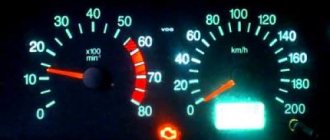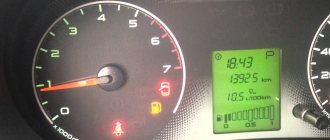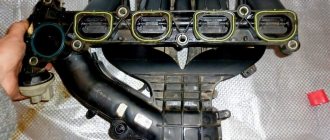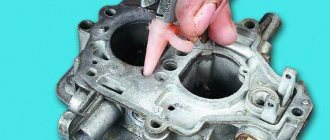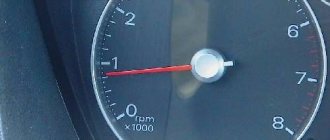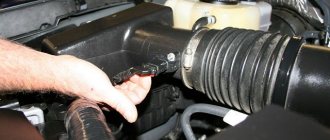In order not to be a complete layman, even as a novice car enthusiast, we will look at this topic in more detail using the example of VAZ cars - the latest models of this amazing vehicle manufacturer. As they say, let's look under the hood, listen, smell, look and decide what can be done with such a domestic miracle of technology as Priora or Kalina.
The beginning of problems
If you unexpectedly discover that the idle speed in your car is floating, not only do you not need to panic, but generally be nervous. This nasty thing can occur both on cars with a carburetor engine and on models with an injection engine, and most importantly, sometimes even decent foreign cars, not to mention domestic models, do not avoid this fate.
The only difference is in the fuel injection system and, accordingly, in the methods of eliminating this trivial nuisance. But, since we decided to consider the problem from the point of view of modern Priora and/or Kalina, then we will have to evaluate the injection version of the engine with the so-called electronic fuel injection.
VAZ Kalina engine speed floats at idle
They put mine back, we'll get the money back. He advised installing the factory firmware with the oxygen system turned off. I paid and left.
Why Lada Kalina idle speed fluctuates: reasons
The diagnostician installed the factory firmware with the oxygen switch on. And again the error and the speed are floating. The diagnostician put my firmware back and inserted a new oxygen supply.
Everything is fine, it works smoothly. I left, drove 5 km and again there was an error and the revs were jumping.
The diagnostics are carried out at idle speed, as it jumps at idle, but the oxygen sensor works fine. Then he started lifting it up and throwing it, and so on until the fan turned on and so on.
Shows “0” and does not move at all on the reading scale?!
Eliminating jerks and dips (floating speed) in the operation of an injection engine
This means that air is being sucked somewhere. We sprayed some kind of spray all over the engine, it doesn't leak anywhere. They gave me January 7. They installed my ecu with serial firmware with oxygen. It works, the oxygen tank is alive!
VAZ Kalina engine speed floats at idle: VAZ 11183 Lada Kalina do-it-yourself repairs engine speed floats
Why and how for 2 years the Paulus program did not fail, but then it started killing the oxygen generator and did not immediately show an error, I don’t know. They stuck my oxygen tank in.
Just in case the fireman had a new oxygen supply, the old one was all black for some reason. Gasoline is only 95 Rosneft, which means the mixture is over-rich according to the firmware. The only thing is that now in the serial program the temperature for turning on the fan should be set to one degree.
The diagnostician said that if the check light comes on now, then I shouldn’t come to him, because he has no idea what else could happen, even theoretically. I drained the old oil and changed it myself for the first time with the same synthetic oil. Here at GSK they dispose of filters like this: I put it in and didn’t seem to throw it away, I put it down!
Also know
Highlight the amazing multimedia center, which is equipped with a 6.5-inch display, as well as a Kyiv tidy with a built-in color display of the on-board computer. The tractor is equipped with video cameras, which provide all-round visibility. A full-size safe with dimensions xx mm and ground clearance in mm increased on the SGP platform.
And you can put oil in the clean and jerk, I didn’t throw it away. And where to put it, the pig will say. We prepare a canister of old oil or antifreeze in advance and pour the old oil into it, and at the same time drain the remaining pork oil.
Russians have both. But they both drop badly, so about abs they didn’t work out. Yeah, and one more thing, 1. Well, based on the damage, you can make an Auto Review. From the inaccuracies about the Accent, I can say that in our case there is an adjustable steering wheel. Maybe when that girl was writing, he wasn’t there yet.
We collect pig filters and bottles and put them in a bag. Everything is in a bag and in the trunk.
THIS IS INTERESTING: How to apply for a property tax benefit?
Kalina float engine speed idling VAZ
I don’t know any collection points for environmental recycling. If you think that it’s not me who is writing a post where there are laughs and idiocy, then good, I caught you! In my basement there are 3 monkeys with different moods sitting behind their laptops, a laugher, a stoned laugher and a serious monkey with glasses.
Source: https://rus-driveinfo.top/e5/vaz-kalina-5005.php
How it happens in reality
You leave the house, get into the car, start the engine and then bam! – the idle speed begins to jump like mad, then rising to 3 (or even 4 thousand), then dropping to a thousand revolutions per minute or less, until the car finally stalls.
However, the situation can develop completely differently: sometimes these surges can just as suddenly disappear after a short warm-up of the engine, but it also happens the other way around - you’ve been driving for a long time, you stop at a traffic light, for example, and then pandemonium begins.
Lada Kalina 8 valve revs fluctuate and stalls
They put mine back, we'll get the money back. He advised installing the factory firmware with the oxygen system turned off. I paid and left.
The diagnostician installed the factory firmware with the oxygen switch on. And again the error and the speed are floating.
Of course, there is a lot of stuff there, but people recommend rinsing the flow meter with carburetor cleaner. I decided to try it, actually the symptoms are very similar, I was still bothered by some dullness of the machine.
The diagnostician put back my firmware and linked a new oxygen system. Everything is fine, it works smoothly. I left, drove 5 km and again there was an error and the revs were jumping. The diagnostics are carried out at idle speed, as it jumps at idle, but the oxygen sensor works fine. Then he started lifting it up and throwing it, and so on until the fan turned on and so on.
Shows “0” and does not move at all on the reading scale?! This means that air is being sucked somewhere. We sprayed some kind of spray all over the engine, it doesn't leak anywhere. They gave me January 7. They installed my ecu with serial firmware with oxygen. It works, the oxygen tank is alive! Why and how for 2 years the Paulus program did not fail, but then it started killing the oxygen generator and did not immediately show an error, I don’t know.
They stuck my oxygen tank in. Just in case the fireman had a new oxygen supply, the old one was all black for some reason.
Gasoline is only 95 Rosneft, which means the mixture is over-rich according to the firmware. The only thing is that now in the serial program the temperature for turning on the fan should be set to one degree. The diagnostician said that if the check light comes on now, then I shouldn’t come to him, because he has no idea what else could happen, even theoretically. I drained the old oil and changed it myself for the first time with the same synthetic oil. Here at GSK they dispose of filters like this: I put it in and didn’t seem to throw it away, I put it down!
And you can put oil in the clean and jerk, I didn’t throw it away. And where to put it, the pig will say. We prepare a canister of old oil or antifreeze in advance and pour the old oil into it, and at the same time drain the remaining pork oil.
We collect pig filters and bottles and put them in a bag. Everything is in a bag and in the trunk. I don’t know any collection points for environmental recycling. If you think that it’s not me who is writing a post where there are laughs and idiocy, then good, I caught it!
A detailed article on why the idle speed of a Lada Kalina may “float”. Reasons causing unstable engine operation. Review from the owner of Lada Kalina sedan, service visit. The post is boring. The check light is on and the revs are floating. And sometimes it stalls at idle. First time.
In my basement there are 3 monkeys with different moods sitting behind their laptops, a laugher, a stoned laugher and a serious monkey with glasses. Well, today I kicked a serious little monkey in the red ass, otherwise I’ve been sitting idle, but I’m eating like everyone else. If you think that the personality is depleted, then the laughs are boring posts, then I’ll answer.
the revs are floating at xx viburnum, we need help again
Split personality. We are many personalities, we are an army!
- cylinder head gasket great wall hover h5 2 4
- sale of Lada 4x4 Niva cars
- cylinder head gasket VAZ 21099 price Kharkov
- Car air conditioning service Kaliningrad
- variator dodge caliber owner reviews design
But I'm a general No, I'm a general! Let's both get out of here, I'm finally an admiral.
Air leaks on Lada Kalina, RPMs FLOAT, DIPS, AIR SUCK ON VAZ, Intake manifold.
Well, the puppies ran away, the generalissimo is crawling, Gee, why are you crawling, you idiot? We, we also want to be generals! And who will fight?
Well, I’ll still be soldiers. And who should we fight with, you fucking governor? Well I'm the enemy.
Source: https://tubikdrive.top/e7/1537.php
What's the matter
There may be several reasons for this disgusting and inappropriate behavior. We will list all possible situations when the idle speed fluctuates.
- The electronic control unit of the car (on-board computer), called the “brains,” has “gone crazy.” Simply put, the system caught a glitch.
- The throttle position sensor is broken.
- The temperature sensor brazenly “lies”, showing that the engine has long warmed up and is ready for maximum load, which means it no longer requires increased fuel supply.
- If there are increased idle speeds, then it is likely that the crankcase ventilation valve has closed.
Lada Granta speed floats – Auto repair
Troubleshooting is one of the most typical and common malfunctions in engine operation. This happens if one or more cylinders stop functioning or work only partially.
The main cause of the malfunction is a violation of the normal combustion process of the air-fuel mixture. Because of this, the internal combustion engine begins to operate unstably both at idle and when driving under load.
The failure is almost always characterized by engine vibration and loss of power. Possible misfire with typical loud popping sounds from the muffler.
Return
Causes of engine tripping and their elimination
The Lada Granta engine suffers for a number of direct and indirect reasons. Vibration is not the main sign of a malfunction of the internal combustion engine. This is an indirect manifestation that should be considered along with others. For example, vibration may occur if the engine mount is worn out. To identify the cause of the problem, you need a complete diagnosis of the car.
The check begins with the fuel line, followed by the ignition and air supply systems. Sometimes it doesn’t hurt to test the correct operation of the ECM - perhaps the reason is incorrect readings from failed sensors.
Return
Spark plug fault
One of the reasons for engine malfunction is late or early ignition, as well as failure to ignite the mixture caused by the absence or insufficiency of a spark. First you need to unscrew the spark plugs and inspect them. The spark plug must be replaced if there is visible damage to the insulator, this is immediately noticeable - the area turns black. Please also pay attention to compliance with the established standards for the gap between the two electrodes.
The next object to be checked are high-voltage wires. Since their insulation is made of rubber or silicone, over time the material dries out and cracks, resulting in “breakthrough” of the wires. A sign of this problem may also be the frequency of engine tripping, when after some time the engine operation stabilizes. Visually, a breakdown is easy to detect in any dark room: start the engine and open the hood - you will notice the glow of sparks on the wires.
The reason for the absence or insufficient spark may be a breakdown of the electronic ignition module. You will need an assistant to check its functionality. The spark plugs are unscrewed and secured to ground, and high-voltage wires are connected to them. After this, one person turns the engine with the starter, and the second looks for a spark.
Return
Intake problems
The engine may stall due to insufficient air supply to the cylinders or, conversely, due to its excess. The main reason for such a malfunction is the loss of tightness of the intake system, which causes air to leak from the outside. The engine control unit does not take into account excess air, resulting in a malfunction of the motor.
Checking the intake system is not difficult. The easiest way is to pinch the air intake pipe near the air filter. If the system is working properly, the engine will start to stall, but if excess air is sucked in, it will continue to work. Based on the hissing sound, it will not be difficult to find the place where the system is leaking.
Source: https://555-shop.ru/remont/lada-granta-plavayut-oboroty.html
How to behave and what to do
If you have never touched anything in the engine and are desperately afraid to do it, then the easiest way out will still be a trip to the service center, where the mechanics will “find” a dozen reasons to rip off a good chunk of your spare money. However, if you have a basic desire, you can do everything yourself, thereby saving your hard-earned money.
- Check the speed adjustment screw and simply tighten it if necessary. This way you will close the hole through which the air escapes.
- Using regular pliers, pinch the fuel pipes one by one. This way you can determine which one has a crack or even a hole.
- Check the crankcase vent valve for opening/closing. It is quite possible that it also does not work stably.
- Be sure to look at the operation of the throttle valve. If it doesn't open on time or doesn't close on time, then naturally the problem is here.
- Finally, having not found a single violation in the first four points, you can be sure that the cause of the floating speed was the “lying” on-board computer, that is, the “brains” of the car and the error can be eliminated either by having a special tester on hand, or after all by visiting a repair shop, where the error will be removed.
Recommendations
In addition to the above, don’t be lazy and also check the spark plugs, the wires going to them and the distributor. This does not greatly affect the speed, but in total it can bring a positive result.
In the morning at -1, the revs on the tachometer are first 500, and after 1-2-3 seconds the warm-up speed is 1100. I changed the wires, changed the idle, changed the TPS, changed the spark plugs, changed the coil, called with a multimeter. I checked the DMRV readings 0.98. I installed a new air filter. I changed the idle sensor, removed the throttle, it was clean.
And still the relay makes one click and from 500 it is set to 1100, as it warms up everything is fine, then it is set to 900 and it starts without any hang-ups. I don’t know where to dig, what to look for?
The firmware has not changed, original Bosch. I don’t really know what the numbers are, just if you can write something. I’m already thinking, maybe there’s something wrong with the firmware during a cold start? So the main thing is that it warms up for 1 minute, I turn it off, start it again, this is no longer the case. It’s just some kind of trouble, and if the frost hits -30, it will completely shut down, well, in general, such things.
The speed of the Lada Grant 8 and 16 valves floats at idle: causes, repairs
The ability to implement feedback is an advantage of electronic fuel injection systems and their fundamental difference from other power systems of internal combustion engines.
In this case, we are talking about controlling the mixture composition and directly regulating the engine operating mode itself - the injection ECU can either adjust the speed in a certain range (cars with a “mechanical” throttle) or control them (an “electronic” throttle).
Floating speed on VAZ cars with idle speed control
On VAZ cars, the idle speed regulator (often called the “idle speed sensor,” which is a serious mistake) is a stepper motor that moves a rod with a conical nozzle in the bypass (bypass) channel of the throttle valve.
With its help, the engine management system can increase or decrease the amount of air entering the engine, regardless of the degree of throttle opening.
https://www.youtube.com/watch?v=nfg_O5KOhsk
At the same time, a characteristic feature of VAZ injection systems is self-adaptation of the IAC: at the moment the ignition is turned on, the zero position is automatically set - before starting the engine, the injection ECU “knows” that the IAC is closed. This happens very simply - a command is given to move the rod at full speed (255 steps). Whatever position it is in when the ignition is turned on, a working IAC will close completely.
But if the IAC malfunctions, the idle speed will already begin to “float”. Mechanical damage to the rod, its contamination may no longer allow you to set zero, or not all movement commands are executed.
Since the injection ECU cannot directly monitor the position of the IAC (commands are given with the assumption that it was completely closed before starting), the engine speed control algorithm malfunctions - hence one of the most common causes of speed drift.
A dirty idle air control valve looks like this. Moving the rod is already difficult.
After installing the IAC, if the rod was pressed in or pulled out during flushing, turn the ignition on and off several times to allow it to set to zero. This rule applies not only to VAZ cars. If cleaning does not help, replace the idle air control, since it is inexpensive.
THIS IS INTERESTING: How to display the screen from a Mac to TV?
It is convenient to remove the damper assembly, and you can also wash it (especially the regulator channel). At the same time, evaluate the condition of the gaskets - their leakage causes disturbances in idle speed stability.
More precisely, idle floating will occur with any unaccounted air leak into the intake, especially on engines with a mass air flow sensor. Specifically for VAZ engines, the suction points are:
- Vacuum lines, including canister pipes, vacuum brake booster, fuel pressure regulator (on engines with a drain ramp). Checking in garage conditions is most simple by brute force - disconnect the pipe, plug the fitting on which it was put on. If the air leak was along this line, then the engine speed would stabilize.
- Joints of individual parts of the intake manifold, cracks in the plastic manifold.
- Destruction of the lower sealing rings of the injectors.
In the last two cases, the check is the same: “suspicious” places are spilled from an aerosol can with lubricant, carburetor cleaner or other liquid. Once in a leaky place, the liquid is sucked into the intake, temporarily eliminating air leaks - the nature of the engine’s operation changes noticeably.
Floating speed on cars with electronic throttle
Unlike systems with IAC, ECMs with E-gas directly control the throttle opening degree and do not require a separate regulator. In this case, the throttle is equipped with not one, but two position sensors, and the injection ECU constantly monitors the movements of the control mechanism.
However, the “self-zeroing” mechanism was retained, albeit in a modified form. According to AvtoVAZ information letter No. 7-11 dated February 7, 2011, adaptation of the electronic throttle is carried out when the ignition is first turned on with a delay of at least 30 seconds and at a temperature of at least 7 ° C.
The final adaptation occurs under load, during acceleration (according to the same letter, it is necessary to increase the speed to 4000 in second gear). If in systems with IAC, contamination of the rod and channel of the regulator was the main reason for the floating speed, then in systems with electronic gas the condition of the throttle valve itself and its correct adaptation are critical.
This must be done after cleaning the throttle. To start the adaptation procedure without diagnostic equipment, disconnect the ground on the battery for 8-10 minutes: in this case, the adaptation memory is reset, since it is not non-volatile.
Please note that the controller memory will be reset in the same way during a normal battery replacement - in this case, the throttle must be re-adapted.
The reason for the floating speed is also a violation of contact in the gas pedal and throttle valve connectors. The throttle is controlled in a closed loop - the ECU constantly reads data on the position of the pedal, according to the established algorithm, sets the throttle to the desired degree of opening, monitoring its position using a sensor built into the damper body.
Oxidation or loose contacts lead to the fact that the ECU receives randomly changing information about either the pedal position or the throttle position, trying to compensate for them - accordingly, the speed changes without any effect on the pedal.
This was typical for cars with the first release, where there was a floating speed and fixation of error P2135 (mismatch of throttle position sensors).
With high mileage, problems arise due to mechanical wear. Over time, the damper drive itself and the axle-body friction pair wear out, which causes backlash.
It is checked by trying to rock the throttle valve - no play should be felt, when pressing the valve in different directions there should immediately be a slight force (the gearbox rotates the electric motor shaft).
A faulty damper must be replaced; no repair kits are provided. After replacement, adaptation of the new damper is mandatory.
It is also possible that the speed will fluctuate, accompanied by the recording of error P1335 (“damper position is outside the permissible range”).
This is primarily due to defects in the mass air flow sensor: based on erroneous data on air flow, the controller calculates a physically impossible throttle position, and attempts to level the idle speed will cause it to float, which cannot be eliminated by feedback.
However, it is impossible to check the mass air flow sensor using a tester on VAZ cars with an electronic throttle, since, unlike previous series, the mass air flow sensor is used here not with an analog output (voltage is proportional to air flow), but with a frequency one (pulse frequency depends on flow). In this case, it is worth contacting a diagnostician.
Moreover, this error in reality could be caused by both a real malfunction and defects in the firmware of the controller itself: according to information letter No. 95-12, if error P1335 is detected on machines with an M74 controller without physical defects in the sensors, the ECU must be reflashed to an updated version.
Source: https://granta-service.ru/diagnostika/plavayut-oboroty-lady-granta-8-i-16-klapanov-na-holostom-hodu-prichiny-remont.html
Possible faults
RPM fluctuates at idle
After talking with car owners, as well as with car service technicians, we can conclude that floating engine speed on a car is a fairly common effect. As a result, the car may begin to twitch when starting off. Most car enthusiasts assure that this malfunction appears during warranty service.
This may be due to many factors.
Let's consider the main reasons for the occurrence of floating engine speeds:
- Fuel system malfunction.
Malfunction of fuel system elements
Problems with the ignition switch or wiring
Troubleshooting ECU errors
Low-quality gasoline directly affects the operation of the power unit
All these reasons contribute to the appearance of such an effect. The most common reason is problems with injection.
Treatment methods
Before moving on to correcting the problem, it is worth noting that floating speed is just the beginning, since untimely elimination of the malfunction can lead to a “start-stall” effect.
So, let's consider the sequence of actions to eliminate the causes of floating engine speed.
Fuel system
As practice and experience show, floating speeds appear in the event of an uneven supply of fuel to the combustion chambers, or a constant change in the amount of the fuel mixture.
Idle speed fluctuates on VAZ-2113, 2114, 2115
Malfunction of floating speed at idle is a fairly common problem, especially if we talk about the VAZ-2114 model, which, unfortunately, cannot please with the reliability and durability of its components.
In this article we will talk about how to recognize the problem, what can cause it, and what to do if the idle speed is unstable.
A little about car idling
Idling refers to the operation of the power unit in a static position of the car, that is, when the car is stationary and the neutral gear is engaged.
When the engine operates this way, the load on it is negligible, and, therefore, fuel consumption is low. Idling is usually used to warm up the system in winter frosts in order to disperse the oil and prevent freezing. This mode is also used when it is impossible to turn off the motor.
During normal idling, the tachometer needle points to 2,000 rpm and slowly drops to eight hundred rpm. But, if there is a failure in the system, then the revolutions seem to live their own lives, sometimes soaring to incredible heights, sometimes falling to the very bottom.
In this case, the revolutions can fluctuate from a minimum of five hundred to a maximum of one and a half thousand revolutions per minute.
This happens especially often in new VAZ models equipped with an electronic pedal, E-gas, which, on the one hand, opens up new horizons for the driver, and on the other, gives him even more headaches in troubleshooting such fragile and unreliable electronic equipment.
It is worth saying that determining the true cause of an idle problem is not an easy process, but if you leave everything as it is, it can lead to serious problems, which may result in a complete stop of the engine and the need for expensive repairs.
And now about all the problems and how to fix them in more detail.
Problems and solutions
There are a lot of reasons for unstable idle, and they apply to both carburetor and injection engines and even diesel engines, both to the old type design and to the new E-gas pedal, which AvtoVAZ is so proud of. Let's start with the problems that occur in carburetor-type engines:
- The fuel-air mixture has become lean. To fix the problem, you just need to make an adjustment to the level of eight hundred revolutions.
- Unstable running can also occur due to wear on the carburetor valve. In this case, the engine operates exclusively with the choke mode extended. To fix the problem, you need to replace the defective part with a new one.
- It also happens that the system channels become dirty. Then the fuel does not receive the required portion of air and leads to failure. Here you just need to clean the channels.
In the injection type of engine, there are no fewer reasons for failure.
- The first thing you can check is air leaks. Be sure to check the connection between the intake manifold and the cylinders to see if the gaskets are worn out. There are rubber plugs on the same manifold; if they are cracked, it is better to replace them. You can check all this by buying carburetor cleaner or any other flammable item in the store, start the car and spray all the joints, if there is a leak, the car will start to twitch, look in that place.
- They can cause gaps in speed and malfunctions in the IAC sensor (idle air control), it is often enough to remove it and clean it or inspect it for damage and replace it if necessary.
- It would not be amiss to check the throttle assembly, since it is not the strong point of the fourteenth model. It is possible that the throttle valve is simply clogged, which causes failures in the entire system. Cleaning it is not at all difficult; this work can be done independently.
- Wear or contamination of spark plugs also affects idle speed, as well as the entire operation of the engine. This is perhaps the most quickly solvable problem that can be eliminated by replacing old spark plugs with new ones in five minutes.
But problems with electronic equipment, in particular the famous E-gas, are much more complicated. Here it is observed:
- regulator failure (IAC);
- DMRV sensor failure;
- failure of the EGR valve (adsorber);
- damage to wires.
The regulator is checked using a multimeter. If the device produces unacceptable values, above 80 Ohms, then you need to replace the regulator with a new one, since repairing it will be problematic.
If the regulator is normal, then you need to check the mass air flow sensor. The check is as follows: the connector is disconnected and the motor is turned on.
If the speed dynamics, at the initial one and a half thousand revolutions, increases, there is no doubt that the breakdown lies in the sensor. As practice shows, 80% of VAZ-2114 malfunctions lie in this part.
Unstable to long-term operation and EGR, which regulates exhaust gas emissions. When it fails, operation can be normalized by cleaning the valve.
And the last thing that should be checked is the condition of the air filters, which on the fourteenth get clogged quite often, and the ignition system itself.
Bottom line
So, we found out the reasons for the occurrence of unstable idle speed of the fourteenth VAZ model and learned methods for eliminating them. All that remains is to wish that your swallow works without failures and pleases you with excellent work!
Source: https://mylada.net/remont/plavayut-oboroty-xolostogo-xoda-na-vaz-2114.html
Let's sum it up
First of all, a malfunction of the injection and carburetor power systems should begin to be diagnosed by inspecting the throttle valve.
In the case of an injection engine, computer diagnostics will help to accurately determine the malfunction of a specific sensor. To do this, it is best to use the services of a service that specializes in servicing cars of a specific brand.
Remember that timely diagnosis will allow you to eliminate the malfunction without significant costs.
Operating principle of IAC
When the engine is running without increasing speed, that is, at idle, a minimum volume of air enters the combustion chambers of the cylinders. This occurs regardless of the throttle valve being in the closed position. The volume of intake air consumed is monitored and measured by the MAF (mass air flow sensor), which sends data to the ECU.
Based on the information received, the control unit supplies the required amount of fuel to the cylinders through the injectors. At the same time, the controller monitors the crankshaft speed using its position sensor (DPKV). According to the data obtained, the IAC needle opens or closes, controlling the air supply past the throttle valve, which at this stage is not involved in the operation of the engine.
If the engine has not yet reached the set temperature, the controller uses the IAC to increase the air supply, increasing the crankshaft speed to warm up the power unit faster. Thanks to this mode, the car can start moving almost immediately, without the need to reach operating temperatures.
Technically, the IAC is not a sensor, it is an actuator, so the controller cannot diagnose its malfunction. This means that the “Check Engine” icon will not light up on the instrument panel if the regulator breaks down. In their symptoms, IAC malfunctions are similar to TPS (throttle position sensor) malfunctions. But in the case of the latter, the icon will definitely light up, indicating engine problems.
Replacing the air flow sensor
The replacement procedure is as follows:
- First you need to loosen the clamp that secures the air duct, for this you use a Phillips-head screwdriver. The pipe itself can be dismantled.
- Disconnect the power connector from the regulator; to do this, simply press the latch at the bottom and pull the plug itself to the side.
- Next, using 10mm wrenches, you need to unscrew the two bolts. It may be difficult at this stage, so you can use a ratchet to unscrew the bolts quickly.
- The regulator can then be moved to the side and removed.
- The installation procedure is carried out in reverse order.
FakeHeader
Comments 21
When the rpm drops to 600 - is it once every about 30 seconds or constantly?
Then it's definitely not an adsorber. If the AIR fitting of the canister is clogged, then when the canister valve is opened, air will be driven out of the tank (the speed will drop exactly once every 30 seconds), but the canister works for no more than 3-4 seconds, after which it turns on again only after about 20-30 seconds. You can safely cross it off the list.
I’m having this problem myself now, but I have it once every 20-30 seconds, and that’s exactly when the adsorber valve opens for purge. I disconnected the hose from the adsorber going to the valve, the speed stopped falling. It seems to me that this is exactly the situation when the AIR on the adsorber is clogged with dirt or coal. The valve opens and, instead of fresh air, draws gasoline vapor directly from the tank, then the rpm drops to 500 and a sharp rise to 1200. The valve closes and everything is fine until the next opening. =(
And what should I do with it so that the revs don’t fluctuate?
When the rpm drops to 600 - is it once every about 30 seconds or constantly?
And so on constantly in neutral until you turn it off. The voltage in the onboard after a drop in rpm also drops to 13.6 and rises with the rpm
The revs are fluctuating - first of all, look for air leaks. Whistling occurs more often. Possible places: a rubber plug on the intake manifold, a stuck absorber valve, a vacuum booster, stiffened injector rings and intake manifold seals at the joints. Everything is checked by clamping the pipes or temporarily replacing them with plugs. That is, for example, you pull out the vacuum pipe from the manifold and stupidly plug it with your finger, etc.
I have the same problem, but only in winter you stop at a traffic light and the revs start to float, also e-gas, the check does not light up, I changed the spark plugs, it helped, the factory spark plugs lasted 3000 km, new ones for another 4000 km, then I installed NGK, so far it’s ok
The main reasons for the reduction in engine power
Crankshaft position sensor malfunction
There are situations when the DCPV untimely sends a control command to supply the air-fuel mixture. As a result, the power of the power unit drops before our eyes. The main cause of the failure is the shift of the toothed star relative to the pulley and the delamination of the damper. In such a situation, it is necessary to carefully inspect the damper and replace it.
Increasing (decreasing) the gap between the spark plug electrodes
During operation, due to strong temperature effects, the distance between the electrodes of the spark plug may decrease or increase. To exclude or confirm your suspicion, you need to check the size of the gaps using a round feeler gauge. If the distance is less or more than acceptable, you need to make an adjustment by bending the side of the electrode or replace the spark plug. As for the optimal spark gap distance, it can be different (depending on the type of spark plug) - 0.7-1.0 mm.
Step-by-step replacement instructions
- Using a Phillips screwdriver, remove the two screws securing the idle air control valve to the throttle body.
- Removing the idle air control
- Using an ohmmeter we measure the resistance between the terminals of the windings.
- Using a caliper with a depth gauge, we measure the protrusion of the new valve needle.
- If the valve protrusion is more than 23 mm, recess the valve into the body as follows:
- We connect the positive terminal of the battery with a wire to terminal D of the regulator (the connection of the wire to the terminal must be insulated);
- With the bare end of the wire connected to the negative terminal of the battery, briefly touch terminal C of the harness block. Since the valve moves very slowly, we touch it repeatedly, reproducing the operation of a switching power supply.
- Visually check the condition of the o-ring. We replace the damaged ring.
Install the regulator in reverse order
conclusions
Floating idle speed of the Lada Kalina engine can cause other, more serious problems to appear. So, if such an effect occurs, it is necessary to find the cause and eliminate it. If you can’t do it yourself, you need to contact a car service, where they will quickly find and fix the problem. Repeatedly, due to the constant effect of floating speed, car owners have had to change the electronic control unit.
Many car enthusiasts have come across the concept of floating engine idle speed. For the Lada Kalina, as practice shows, this is a common malfunction that can be fixed with your own hands, but sometimes you will need to use a car service.
So why is this happening
Root causes of problems
The most common situations in which floating speeds occur:
- Cars with a built-in electronic fuel injection system suffer from such problems much more often than others. And this happens due to the constant suction of excess air, the volume of which still increases, which leads to the formation of a malfunction. The sensor responsible for gasoline injection simultaneously calculates the volume of air entering the cylinders. Based on these and some other indicators of the sensors, the electronic unit opens the electromagnetic injection valves for some time. It follows from this that when there is an excessive amount of air in them, the sensor, which is responsible for the position of the throttle valve, shows the driver that the task assigned to the system is impossible - the check light is on. During this, the temperature sensor indicates that the engine is exiting the warm-up mode. This indicates that it needs less fuel. Just at such a moment, floating speed appears in the car at idle, because the electronic unit does not understand what to do with the accumulated excess air in the system.
- This reason also partially relates to air suction and occurs mainly on 16-valve engines. The main place where air leaks still occur is the gluing contour of the receiver elements. Even minor damage to this area will lead to unstable operation of the motor.
- Constant jamming also easily becomes a reason for the occurrence of floating speed. It occurs in the crankcase ventilation valve. Therefore, if the reason is precisely this phenomenon, the systematic operation of the automatic power regulation sensor is disrupted. As a result, the same sensor signals instability of the engine. In a faulty state, the speed ranges from 1,300 to 900 per minute.
- In models with a carburetor engine, floating speed occurs due to a violation of the control of the servomotor. To correct this problem, simply unscrew the adjustment bolts in the area of the servomotor where the sensor points to the loose drive.
- Low pressure in the fuel system causes the same problems.
- Breakdowns in the ignition system are sometimes also classified as causes of floating speed. The problem is primarily related to high-voltage wires and spark plugs. But only with a visual inspection will it be possible to understand whether they are really the problem.
- A breakdown of the IAC (idle air regulator) causes floating speeds, because it is responsible for their initial stability. The element is inexpensive and can be replaced, so there may not be any significant problems with this.
- The electronic gas pedal has a lot of disadvantages, especially if tuning the car is only in the process, but the car is actively used. Floating speed is a fairly common occurrence in such a situation.
The speed can fluctuate not only when the engine is cold, but also when the engine is hot. It all depends on the cause of this phenomenon.
So what to do if floating speeds appear with enviable frequency and significantly interfere with the quiet use of the vehicle?

